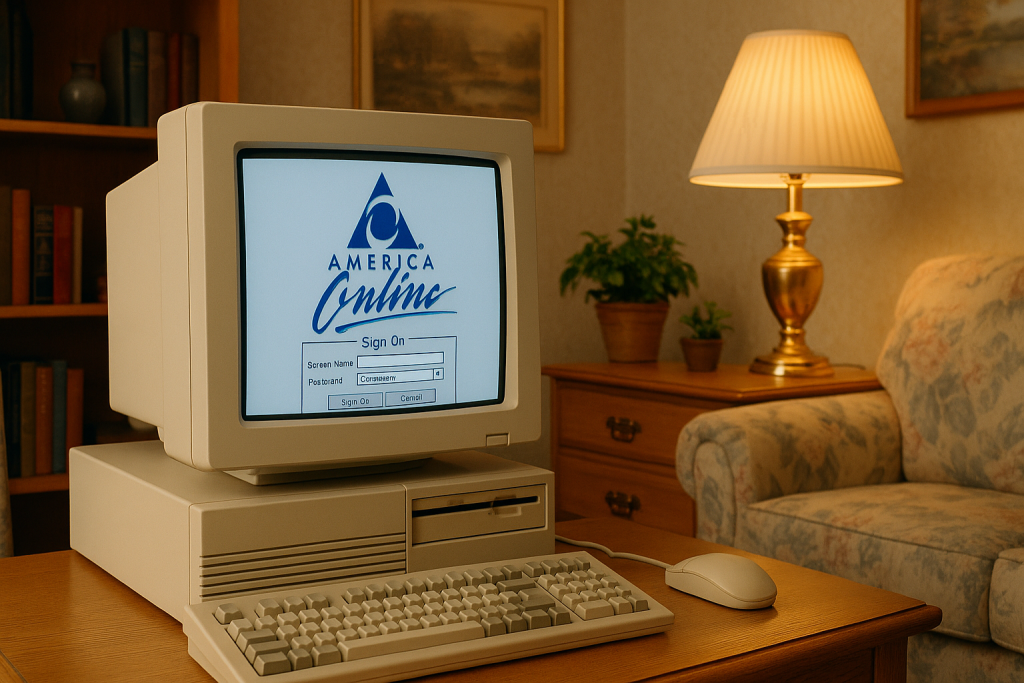AOL Is Finally Shutting Down Dial-Up Internet, Ending One of the Last Links to the 1990s Online Era
After more than three and a half decades of crackling modem sounds and “You’ve Got Mail” nostalgia, AOL is officially ending its dial-up internet service on September 30, 2025. That familiar gateway to the internet for millions in the ’90s will soon go silent, marking a quiet but powerful end to one of the most iconic chapters in tech history.

35 Years Later, the Modem Hangs Up
AOL, originally known as America Online, announced that it is retiring its dial-up internet and associated software, part of what it called a routine product evaluation. While the number of users still clinging to this antiquated connection method is small, just around 163,000 households as of 2023, according to the U.S. Census Bureau, the symbolism is immense.
This isn’t just a technical update. It’s the retirement of a sound, a feeling, a memory of when logging on was a deliberate, slow, and magical ritual. For many, AOL wasn’t just an internet provider, it was the internet.
Yahoo Pulls the Plug, But Email Lives On
AOL’s parent company, Yahoo, confirmed the move, explaining it as part of broader efforts “to innovate and meet the needs of today’s digital landscape.” Users who still maintain an AOL email address can breathe easy, though, the change won’t affect free email accounts or other AOL-branded services.
This means your @aol.com email address is safe, even as the infrastructure that once supported it, those humming modems and busy signals, finally goes offline for good.
A Cultural Flashback: You’ve Got (Nostalgic) Mail
If you grew up in the 90s, AOL was more than a service. It was a full-blown cultural phenomenon.
- Those bulky CD-ROMs mailed to your house promising “1000 FREE HOURS!”
- Chat rooms with mysterious usernames
- Instant Messenger (AIM) status updates and away messages that read like teenage poetry
- That signature “You’ve Got Mail” voice clip that went on to inspire a Hollywood rom-com
In fact, 1998’s You’ve Got Mail, starring Tom Hanks and Meg Ryan, centered entirely around a blossoming romance nurtured on AOL’s messaging platform. It wasn’t just a plot device, it was a tech reality millions were living at the time.
From Dominance to Dial Tone Silence
At its peak, AOL was a behemoth. It dominated the early internet service provider (ISP) market in the U.S., boasting over 26 million users at one point. It helped usher in the age of the digital native, giving Americans a platform for email, news, chat, and web browsing before broadband became mainstream.
But as broadband, cable, and now fiber internet spread across the country, dial-up slowly faded into obscurity. AOL pivoted toward content, email services, and digital advertising. Over the years, its identity became murkier, bouncing through mergers and acquisitions, including its controversial 2000 merger with Time Warner and its eventual acquisition by Verizon and later Yahoo.
Yet somehow, dial-up persisted. Whether in rural communities, low-income households, or by those simply resistant to change, the service continued to quietly operate, even as the rest of the world moved on to gigabit speeds and 5G networks.
What Happens to Remaining Dial-Up Users?
For the 163,000 remaining dial-up customers, the shutdown is a firm deadline to migrate. In many rural or underserved areas, broadband access is still limited or unaffordable, which may force some households to either upgrade their infrastructure or lose home internet entirely.
Yahoo has not detailed what support, if any, it will offer these users. It’s unclear if discounts for alternate services will be provided or if AOL’s dial-up subscribers will be offered migration assistance to other internet providers.
For those in remote regions with few wired options, switching to satellite internet, especially Starlink, may be the most practical alternative. It offers decent speeds and broader availability in areas where traditional ISPs fall short.
| Product | Brand | Name | Price |
|---|---|---|---|
 | Generic | SpaceX Starlink Gen 3 Standard Kit: High-Speed, Low-Latency Internet (Latest Model) Ultra Portable WiFi Router - Elegant Design, starlink Travel Router WiFi 6, Satelital Connectivity | Check Price on Amazon |
* If you buy through links on our site, we may earn an affiliate commission. For more details, please visit our Privacy policy page.
Regardless, the sun is setting on a service that once felt like the dawn of a new age.
Why This Moment Matters
It may seem quaint, or even absurd, that anyone still used dial-up in 2026. But the announcement taps into a collective nostalgia and a recognition that the internet has matured far beyond its quirky, experimental roots.
- In the 90s, we logged on to the internet.
- Today, we live on it, perpetually connected through smartphones, smart homes, and AI.
AOL dial-up reminds us of a time when digital life was simpler, slower, and somehow more intentional. When families took turns using the single phone line, when going online meant being temporarily unavailable in the real world.
End of the Line, but the Memories Linger
While AOL’s dial-up service is being unplugged for good, its legacy lives on in how it shaped internet culture. It helped launch the idea of being online as a social and personal experience, not just a utility. It was messy, chaotic, charming, and foundational.
In an age where technology moves at breakneck speed, AOL’s farewell to dial-up is a rare pause, a moment to look back. So as September 30 approaches, maybe, just maybe, somewhere in a dusty closet, someone will power up a beige desktop, hear that old modem tone one last time, and remember when the internet came with a chime and a smile:
“You’ve Got Mail.”